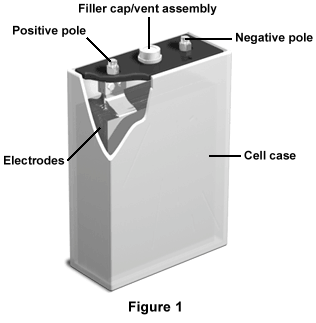
The Nickel-Zinc Battery
With the current concern over world energy supplies and the depletion of non-renewable fuels, nickel-zinc batteries are becoming important in the development of electric vehicles, including small vans and passenger cars. These batteries are characterized by a high specific energy and power capability, can operate within a wide range of temperatures, and are of a relatively low cost.

Figure 1 shows a classically constructed nickel-zinc battery. The top of the case displays both positive and negative poles, which are fastened by pole nuts, a sight port, and a filler cap/vent assembly. The cutout portion displays the positive and negative electrodes, as well as the separators.
The nickel-zinc battery uses the same nickel electrode used in nickel-cadmium batteries and the zinc electrode used for silver-zinc batteries. The use of these materials is to hopefully achieve a goal of long-life characteristics much like the nickel-cadmium battery, while having the excellent capacity of a zinc anode. This battery type is not used commercially on a wide scale because of the zinc electrode's short life; however, as time goes on, its cycle time is anticipated to improve and it will probably have commercial significance, because of its high specific energy, as well as its relatively low cost. It operates between 1.55 and 1.65 volts. The capacity in the nickel electrode used during discharge must be replaced with an overcharge, and usually, cells are made with extra zinc-active material to accomplish this.
ChemistryThere are several types of nickel electrodes that the nickel-zinc battery uses: the pocket plate electrode, the sintered-nickel electrode, the non-sintered nickel electrode, and the lightweight substrate electrode. The pocket plate electrode uses the same basic electrode as nickel-cadmium and nickel-iron batteries. These types of electrodes are built by loading nickel hydroxide hydrate, which is the active material, and a conductive additive like graphite or nickel flakes into flat tube pockets, which are eventually made into electrodes. The sintered-nickel electrode is made by sintering high bulk density carbonyl nickel powder, thus transforming it into a porous plaque. Non-sintered nickel electrodes reduce the amount of nickel used. They are made by kneading an electrode strip of nickel hydroxide hydrate, graphite additive, and a teflon plastic binder. Lightweight substrate electrodes are made from an electroformed foil sheet with a hole pattern, and nickel hydroxide hydrate as the active material.
The zinc electrode has fewer variations, and is built using zinc oxide, additives, and a plastic binder. By pressing or rolling the dry powder on the electrode strips, the zinc electrodes are assembled. The electrolyte is usually a potassium hydroxide, though some use lithium hydroxide as additive material to improve semiconductive properties.
The traditional nickel-zinc battery has a prismatic cell design, which means the battery uses multiple positive and negative electrodes, all of which are isolated by separators, and all connected to the appropriate terminals. Another version of the nickel-zinc battery utilizes the l design, which was originally invented because of problems with the zinc electrode. The negative electrode is vibrated, causing turbulence in the electrolyte. This accomplishes the dispersion of dissolved zinc oxide and lowers the zincate concentration gradients, discouraging dendrite formation. A third type is the sealed cell battery, where gases formed during the charge recombine within the cell.